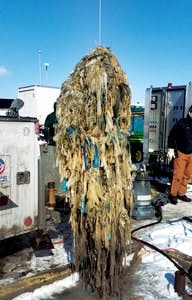Rags, wipes and other non-flushable products are causing massive clogs in pumps around the country.
Clogged pumps in wastewater systems are every operator’s worry, holding up operations and requiring a messy and disruptive maintenance call to clear the clog. All types of locations—from municipal collections and private lift stations to small ejector pumps and large pump stations—can be plagued by clogs.
This problem is not new, but with a higher concentration of disposable wipes in today’s sewage, it has reached a crisis level in many locations. Congested pumps, often choked with wipes and debris, were once the everyday reality for a nursing home in Michigan, a municipal pump station in California and a prison in Las Vegas. After incorporating a grinder into their systems, the operators for all three facilities have discovered that clogged pumps do not have to be a fact of life.
Finding a Solution in Michigan
From the health and safety of every resident and staff member to the task of maintaining a sprawling facility, running a nursing home is a demanding job. While managers spend their days tending to resident and staff concerns, the pipes face the challenge of handling a new kind of sewage.
Disposable cleaning products, “flushable” hygenic wipes and disinfecting wipes are the go-to for many nursing home facilities. In a small Michigan township, a nursing home was sending flushable wipes and adult diapers into the local city sewer system and clogging sewer pipes, causing manholes to pop off and raw sewage to flow into the street.
“In one instance, the line plugged and it flooded some nearby homes,” said Jason Gwinn of Gwinn Brothers Construction, the contractor hired to resolve the plumbing issues. “Worse, the nursing home had to pay to clean up the mess. The township asked them to install a sewer grinder.”
After discussing the problem with local sewer officials, the contractor installed a Monster 3-HYDRO sewage grinder inside a manhole. The dual-shafted grinder uses slow-speed, high-torque power to cut through wipes, rags, disposable diapers and other trash and turn it into small particles that flow harmlessly through sewer pumps and pipelines.
According to a nursing home facility manager, the sewage grinder is easy to install, requires little to no maintenance, is proven to be reliable in thousands of installations, and solves sewer debris problems. “I never knew something like these sewer grinders existed,” Gwinn said. “The nursing home is very happy with it.”
Moving Wipes In California
When the Santa Margarita Water District (SMWD) was formed in 1964 by a group of ranchers who wanted a reliable water source for their cattle, the district served more cows than people. The area has since grown to more than 150,000 homes and businesses, and the SMWD maintains more than 1,200 miles of water and sewer lines across a 62,674-acre service area.
Built in 1977, the reclaimed water facility was initially intended to provide water for landscape irrigation in the district. Today, during a typical 12-month period, the facility brings in 680 million gal of sewage and sends out 620 gal of reclaimed water. Originally, the facility relied on a mechanically cleaned bar screen to remove debris from the waste system. Over time, safer, more reliable solutions came on the market, and the bar screen was replaced by a CMD single-drum Channel Monster that would shred debris before it reached the pumps, preventing clogs and damage.
Ron Johnson, facilities supervisor for the facility, said pump clogging was not an issue after the grinder was installed in the 1990s—until 2012, when the influent became loaded with disposable wipes. “The pumps would begin to lose efficiency as the wipes loading increased, and we would have to run all four pumps to maintain plant production,” Johnson said. “Once they reached 60 Hz, we would need to shut down the plant to derag the pumps.”
The deragging process became necessary every two to six weeks. Deragging took two operators approximately two hours and required a complete plant shutdown. These unplanned shutdowns were costing the district 1 acre-ft of reclaimed water production per month, and the labor costs added up to approximately $15,000 per year.
“We considered changing out the current pumps to a new set of chopper pumps, but this option came with a $100,000 price tag,” Johnson said. “We still needed to maintain our inlet Channel Monster to take care of the larger debris the pumps couldn’t handle. Johnson ultimately decided to upgrade to a new Wipes Ready perforated drum configuration.
The perforated drum on the newest generation of Channel Monsters was designed to better capture the wipes and rags that can pass through traditional coil drums. “This upgrade cost significantly less than purchasing a whole new set of pumps,” Johnson said. “Plus, this is a reliable, long-term solution.” Since the new drums were installed, the district has eliminated pump clogs at the facility, and has returned to using two pumps at a time instead of all four. Pumping energy costs have decreased $78,000 per year.
Eliminating Clogs in Las Vegas
Inmates at the Clark County Detention Center (CCDC) in Las Vegas use their toilets as trash cans, flushing everything from t-shirts and shoes to books and blankets. When the Las Vegas Water Pollution Control Facility (WPCF) showed CCDC maintenance personnel a picture of a bright orange jail-issued shirt emblazoned with “CCDC” in its headworks, they knew they needed to install grinders.
The first Muffin Monster grinder, positioned underground between the booking building and parking structure, successfully reduced wastewater solids. CCDC installed five more. The grinders only require yearly checks on the cutter wear and torque to keep the grinders running smoothly and clog-free.
Because the building expansion only allowed for one grinder, CCDC had to find space for additional ones. Three grinders are underground, one is installed horizontally in a narrow closet, a larger grinder is mounted on a steel support 5 ft off the ground, and a grinder is suspended from the ceiling in the laundry area. Four of the grinders process wastewater from specific areas, and all the grinders are equipped with their own PLC panel. The grinders are put to work, and the CCDC no longer fields calls asking how a jumpsuit ended up in the influent at the WPCF.


